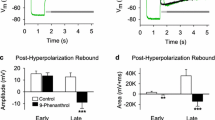Summary
-
1.
The effects of strychnine on the voltage-dependent Ca2+ current (I Ca) were studied in physically isolatedAplysia neurons and enzymatically dissociated frog sensory neurons of the dorsal root ganglion. Neurons were studied under the internal perfusion and the voltage clamp condition.
-
2.
Strychnine decreased theI Ca with threshold concentrations for effect at 1 to 10µM. The depression ofI Ca increased with strychnine dose without effects on the current-voltage relation ofI Ca. The effects of low concentrations of strychnine were reversible, but recovery was incomplete at higher concentrations. The potency of strychnine was about 10 times less than that of diltiazem, an organic Ca2+ antagonist. At 100µM theI Ca ofAplysia neurons was reduced to about half of the control. This concentration of strychnine also reduced the peak amplitude ofI Ca of frog sensory neurons.
-
3.
These results indicate that, in addition to its actions on transmitter responses and on Na+ and K+ currents, strychnine has effects onI Ca that have not previously been appreciated.
Similar content being viewed by others
References
Akaike, N., Ito, H., Nishi, K., and Oyama, Y. (1982). Further analysis of inhibitory effects of propranolol and local anesthetics on the calcium current inHelix neurones.Br. J. Pharmacol. 7637–43.
Akaike, N., Inoue, M. and Krishtal, O. A. (1986). “Concentration clamp” study ofgamma-aminobutyric acid-induced chloride current kinetics in frog sensory neurones.J. Physiol. (Lond.)379171–185.
Ascher, P. (1972). Inhibitory and excitatory effects of dopamine onAplysia neurones.J. Physiol. (Lond.)225173–209.
Augustine, G. J., Charlton, M. P., and Smith, S. J. (1986). Calcium action in synaptic transmitter release.Annu. Rev. Neurosci. 10633–693.
Blaustein, M. P. (1968). Barbiturates block sodium and potassium conductance increases in voltage-clamped lobster axon.J. Gen. Physiol. 51309–319.
Blaustein, M. P., and Goldman, D. E. (1966). Competitive action of calcium and procaine on lobster axon. A study of the mechanism of action of certain local anesthetics.J. Gen. Physiol. 491043–1063.
Byerly, L., and Hagiwara, S. (1982). Calcium currents in internally perfused nerve cell bodies ofLimnea stagnalis.J. Physiol. (Lond.)322503–528.
Byerly, L., and Moody, J. W. (1984). Intracellular calcium ions and calcium currents in perfused neurones of the snail,Lynmae stagnalis.J. Physiol. (Lond.)352637–652.
Carbone, E., and Lux, H. D. (1984). A low voltage-activated calcium conductance in embryonic chick sensory neurons.Biophys. J. 46413–418.
Cote, I. L., and Wilson, W. A. (1980). Effects of barbiturates on inhibitory and excitatory responses to applied neurotransmitters inAplysia.J. Pharmacol. Exp. Ther. 214161–165.
Curtis, D. R., and Johnston, G. A. R. (1974). Amino acid transmitters in the mammalian central nervous system.Ergeb. Physiol. 6997–188.
Curtis, D. R., Duggan, A. W., and Johnson, G. A. R. (1971). The specificity of strychnine as a glycine antagonist in the mammalian spinal cord.Exp. Brain Res. 12547–565.
Faber, D. S., and Klee, M. R. (1980). Strychnine interactions with acetylcholine, dopamine and serotonin receptors inAplysia neurons.Brain Res. 214161–165.
Grenningloh, G., Rienitz, A., Schmitt, B., Methfessel, C., Zensen, M., Beyreuther, K., Gundelfinger, E. D., and Betz, H. (1987). The strychnine-binding subunit of the glycine receptor shows homology with nicotinic acetylcholine receptors.Nature 328215–221.
Groul, D., and Weinreich, D. (1979). Two pharmacologically distinct histamine receptors mediating membrane hyperpolarizations on identified neurons ofAplysia californica.Brain Res. 162281–301.
Hattori, K., Akaike, N., Oomura, U., and Kuraoka, S. (1984). Internal perfusion studies demonstrating GABA-induced chloride responses in frog primary afferent neurons.Am. J. Physiol. 246C259-C265.
Ishizuka, S., Hattori, K., and Akaike, N. (1984). Separation of ionic currents in the somatic membrane of frog sensory neurons.J. Membr. Biol. 7819–28.
Ito, H., and Nishi, K. (1982). Frequency-dependent depression of ganglionic transmission by propranolol and diltiazem in the superior cervical ganglion of guinea pig.Br. J. Pharmacol. 77359–362.
Ito, H., and Sakanashi, M. (1985). Effects of dilitiazem on the TEA-induced plateau of nodose ganglion action potential.Arch. Int. Pharmacodyn. Ther. 27728–38.
Kehoe, J. (1972). Three acetylcholine receptors inAplysia neurones.J. Physiol. (Lond.)225115–146.
Kordas, M. (1970). The effect of procaine on neuromuscular transmission.J. Physiol. (Lond.)209689–699.
Krishtal, O. A., Marchenko, O. A., and Shakhovalov, Y. A. (1983). Receptor for ATP in the membrane of mammalian sensory neurons.Neurosci. Lett. 3541–45.
Lee, K. S., Akaide, N., and Brown, A. M. (1980). The suction pipette method for internal perfusion and voltage clamp of small excitable cells.J. Neurosci. Meth. 257–78.
McCaman, R. E., and Ono, J. K. (1982).Aplysia cholinergic synapses: A model for central cholinergic function. InProgress in Cholinergic Biology: Model Cholinergic Synapses (Hanin, I., and Goldberg, A. M., Eds.), Raven Press, New York.
Nishi, K., and Oyama, Y. (1983). Barbiturates increase the rate of voltage-dependent inactivation of the calcium current in snail neurones.Br. J. Pharmacol. 80761–765.
Ono, J. K., and Salvaterra, P. M. (1981). Snakeα-toxin effects on cholinergic and noncholinergic responses ofAplysia californica neurones.Soc. Neurosci. 1259–270.
Oyama, Y., Akaike, N., and Nishi, K. (1986). Persistent calcium inward current in internally perfused snail neuron.Cell. Mol. Neurobiol. 671–85.
Shapiro, B. I., Wang, C. M., and Narahashi, T. (1974). Effects of strychnine on ionic conductances of squid axon membrane.J. Pharmacol. Exp. Ther. 18866–76.
Slater, N. T., and Carpenter, D. O. (1984). A study of the cholinolytic actions of strychnine using the technique of concentration jump relaxation analysis.Cell. Mol. Neurobiol. 4263–271.
Slater, N. T., Carpenter, D. O., Haas, H. L., and David, J. A. (1984). Blocking kinetics at excitatory acetylcholine responses onAplysia neurons.Biophys. J. 4524–25.
Steinbach, A. B. (1968). Alteration by Xylocaine (lidocaine) and its derivatives of the time course of the end-plate potential.J. Gen. Physiol. 52144–161.
Taylor, R. E. (1959). Effect of procaine on the electrical properties of squid axon membrane.Am. J. Physiol. 1961071–1078.
Yarowsky, P. J., and Carpenter, D. O. (1978). A comparison of similar ionic responses togamma-aminobutyric acid and acetylcholine.J. Neurophysiol. 41531–541.
Author information
Authors and Affiliations
Rights and permissions
About this article
Cite this article
Oyama, Y., Akaike, N. & Carpenter, D.O. Strychnine decreases the voltage-dependent Ca2+ current of bothAplysia and frog ganglion neurons. Cell Mol Neurobiol 8, 307–314 (1988). https://doi.org/10.1007/BF00711172
Received:
Accepted:
Issue Date:
DOI: https://doi.org/10.1007/BF00711172



